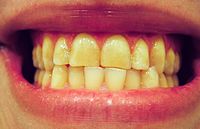
Photo from wikipedia
Excessive masticatory muscle activity is generally present in awake bruxism, which is related to increased anxiety and stress. It has been hypothesized that biofeedback could potentially manage awake bruxism, however,… Click to show full abstract
Excessive masticatory muscle activity is generally present in awake bruxism, which is related to increased anxiety and stress. It has been hypothesized that biofeedback could potentially manage awake bruxism, however, its effectiveness has not been empirically analyzed in a systematic manner. Therefore, this systematic review was designed to determine the effectiveness of biofeedback compared to other therapies in adults with awake bruxism. Extensive searches in five databases looking for randomized controlled trials (RCTs) that included biofeedback to manage awake bruxism were targeted. The risk of bias (RoB) assessment was conducted using the Cochrane RoB-2 tool. Overall, four studies were included in this systematic review, all of which used the electromyographic activity of the masticatory muscles during the day and night as the main endpoint. Auditory and visual biofeedback could reduce the excessive level of masticatory muscle activity in a few days of intervention. The majority of the included studies had a high RoB and only one study had a low RoB. The standardization of the biofeedback protocols was also inconsistent, which makes it difficult to establish the ideal protocol for the use of biofeedback in awake bruxism. Thus, it is proposed that future studies seek to reduce methodological risks and obtain more robust samples.
Journal Title: International Journal of Environmental Research and Public Health
Year Published: 2023
Link to full text (if available)
Share on Social Media: Sign Up to like & get
recommendations!